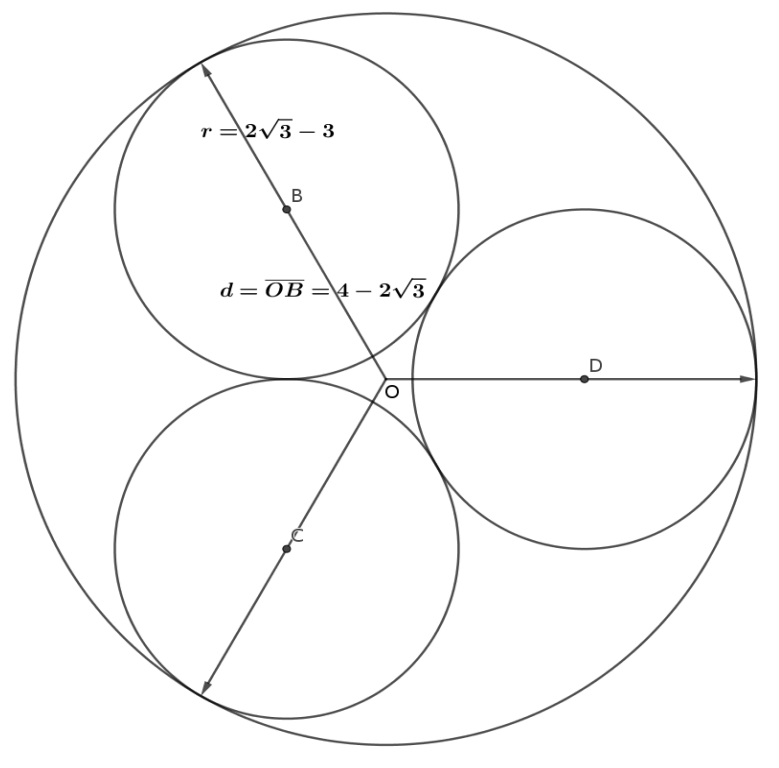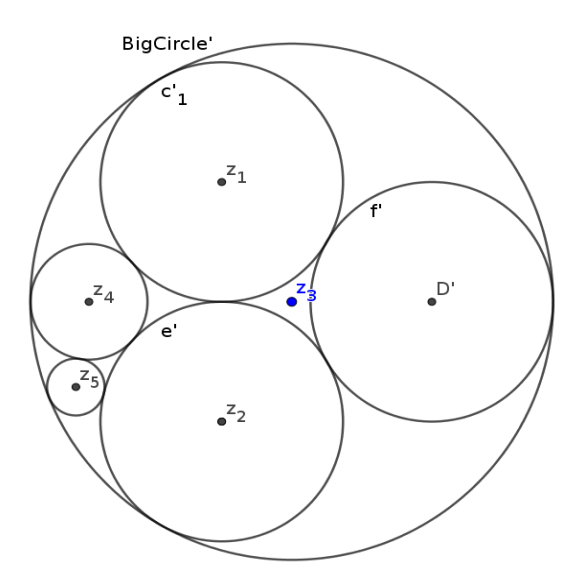Apollonius Circles

Suppose we have a circle with radius 1 and we want to construct three tangent circles inside of it. Refer to figure 1. How can we find points $B$, $C$, and $D$. We can let $O=(0,0)$.
We also know that the 'radius of eacg small circle', (call them $r$) added to the 'distance of point $B$ from the origin', (call it $d$) is $1$, the radius of the large circle. $$r+d=1. \tag{1} \label{1}$$
Since the three points are evenly spaced around the circle, their direction vectors are $$\text{for B: }\left(\cos\left(\frac{2\pi}{3}\right),\sin\left(\frac{2\pi}{3}\right)\right)=\left(-\frac{1}{2},\frac{\sqrt{3}}{2}\right)\leftarrow\text{direction vector}$$ $$\text{for C: }\left(\cos\left(\frac{4\pi}{3}\right),\sin\left(\frac{4\pi}{3}\right)\right)=\left(-\frac{1}{2},-\frac{\sqrt{3}}{2}\right)\leftarrow\text{direction vector}$$ $$\text{for D: }\left(\cos\left(\frac{6\pi}{3}\right),\sin\left(\frac{6\pi}{3}\right)\right)=(1,0)\leftarrow\text{direction vector}$$ Next we know that the distance between the centers of two of the smaller circles is $2r$. $$\sqrt{\left(B_{x}-D_{x}\right)^{2}+\left(B_{y}-D_{y}\right)^{2}}=2r$$ and $$B=d\cdot\left(-\frac{1}{2},\frac{\sqrt{3}}{2}\right)\text{ and }D=d\cdot(1,0)$$ substituting $$\sqrt{\left(-\frac{d}{2}-d\right)^{2}+\left(\frac{d\sqrt{3}}{2}-0\right)^{2}}=2r$$ $$\sqrt{\frac{9}{4}d^{2}+\frac{3d^{2}}{4}}=2r$$ $$\frac{3d}{2}+\frac{d\sqrt{3}}{2}=2r \tag{2} \label{2}$$ Now solve $\eqref{1}$ and $\eqref{2}$ simultaneously to get $$d=-2\sqrt{3}+4$$ $$r=2\sqrt{3}-3$$ If we had used a radius of $R$ for the big circle instead of $1$, we would get $d=-2R\sqrt{3}+4R$ and $r_{2}=2R\sqrt{3}-3R$. With these tangent circles, we can get started using the method of Descartes to find some of the interior circles.A minor issue with the method is that determining bend $k_{4}$ from any 3 circles will result in two values, since the root can be either positive or negative. Also, having chosen a $k_{4,}$ the determination of $z_{4}$ will also yield two answers for the same reason. That means, however, that there are four possible choices for $z_{4}$. $$z_{4a}=\frac{z_{1}k_{1}+z_{2}k_{2}+z_{3}k_{3}+\sqrt{k_{1}k_{2}z_{1}z_{2}+k_{2}k_{3}z_{2}z_{3}+k_{1}k_{3}z_{1}z_{3}}}{+k_{4}}$$ $$z_{4b}=\frac{z_{1}k_{1}+z_{2}k_{2}+z_{3}k_{3}-\sqrt{k_{1}k_{2}z_{1}z_{2}+k_{2}k_{3}z_{2}z_{3}+k_{1}k_{3}z_{1}z_{3}}}{k_{4}}$$ $$z_{4c}=\frac{z_{1}k_{1}+z_{2}k_{2}+z_{3}k_{3}+\sqrt{k_{1}k_{2}z_{1}z_{2}+k_{2}k_{3}z_{2}z_{3}+k_{1}k_{3}z_{1}z_{3}}}{-k_{4}}$$ $$z_{4d}=\frac{z_{1}k_{1}+z_{2}k_{2}+z_{3}k_{3}-\sqrt{k_{1}k_{2}z_{1}z_{2}+k_{2}k_{3}z_{2}z_{3}+k_{1}k_{3}z_{1}z_{3}}}{-k_{4}}$$ Just as a reminder,$$k_{4}=k_{1}+k_{2}+k_{3}\pm2\sqrt{(k_{1}k_{2}+k_{2}k_{3}+k_{3}k_{1}}$$ and a negative $k$ means that the circle with the negative surrounds the others.

Which ones we actually need depend upon which quadrant the final answer will land in. We can cut this down to just one possibility by translating the circles far enough into quadrant $1$ and only looking for the circle that is inside (that is in the middle of) the three circles. After doing that translation and limiting the circle sought, then $z_{4a}$ will be the correct center point and $1/k_{4}$ will be the new radius. It is very important that the root be computed using complex numbers (i.e. use De Moivre's Theorem) even though some software, such as Geogebra, will do the arithmetic with non-complex point values, the answer will be incorrect unless complex arithmetic is used.